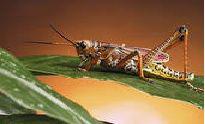Natural Solutions to Things That Bug You (27 page)
Read Natural Solutions to Things That Bug You Online
Authors: Myles Bader

MILLIPEDE
General Information:
 These creepers can grow up to 200 pairs of legs and usually help to eliminate decaying material.
These creepers can grow up to 200 pairs of legs and usually help to eliminate decaying material.
However, they are also pests and may attack roots and stems of healthy plants, especially if they need water during a dry spell. When they get a taste of sweet sap they will keep feeding. They have been known to do a lot of damage to seedlings.
 They prefer damp and dark locations, such as a basement. When bothered they will curl up in a “C” shape similar to a pillbug. When they curl up they will remain still when touched and play dead.
They prefer damp and dark locations, such as a basement. When bothered they will curl up in a “C” shape similar to a pillbug. When they curl up they will remain still when touched and play dead.
FUNGUS/MOLDS
THERE’S A FUNGUS AMONG US
Mix 2 tablespoons of baking soda in 1 quart of water and mix well. Place the mixture into a spray bottle and spray directly on fungus every 2-3 days as needed.
PASS THE SALAD DRESSING
Over 85% of all molds can be killed with white vinegar. Make sure that the vinegar is at least 5% to be effective.
MOLD KILLERS
Borax, sodium borate, table salt and lime are all commonly use mold killers. Baking soda and food-grade diatomaceous earth (DE) can also be used very effectively.
MILD LOVES HUMIDITY
Dehumidifiers, fans and air conditioners will reduce the amount of mold by reducing the level of humidity in the home.
BLEACH ‘EM OUT
To control mold place 1 cup of household bleach into 1 gallon of water and mix well and sponge or spray on to control the mold spores.
SURGICAL REMOVAL
If you are having a problem with black spot fungus, you will need to remove and destroy the affected limb. It is best to find all the areas where it is hiding and remove it before winter sets in. The fungus is able to survive the winter on fallen leaves and even the stems of roses.
AMARANTH FIGHTS FUNGI
 Use about 2 pounds of amaranth leaves or fresh grain and extract the juices. Mix the juice with 2 quarts of water and use as a spray. Strain if necessary and allow the mixture to sit for 1 hour before using. This will combat the following fungi: Alternaria, cercospora, colletotrichum, curvularia, helminthosporium and pestalotia. Bring a leaf with fungus on it to your local gardening supply house for identification.
Use about 2 pounds of amaranth leaves or fresh grain and extract the juices. Mix the juice with 2 quarts of water and use as a spray. Strain if necessary and allow the mixture to sit for 1 hour before using. This will combat the following fungi: Alternaria, cercospora, colletotrichum, curvularia, helminthosporium and pestalotia. Bring a leaf with fungus on it to your local gardening supply house for identification.
FUNGI AND GINGER
 A number of fungi can be killed using ginger. These include leaf mold, early blight, frogeye and leaf spot. The rhizome needs to be crushed and the juice used in a spray. Test and area first to avoid any plant damage and allow it to remain overnight.
A number of fungi can be killed using ginger. These include leaf mold, early blight, frogeye and leaf spot. The rhizome needs to be crushed and the juice used in a spray. Test and area first to avoid any plant damage and allow it to remain overnight.
GRASSHOPPERS

Grasshoppers; are a real pest in the family garden because of their big appetites. They prefer grasses, clover and weeds, but when these are not available will go for the veggies. Their powerful hind legs allow them to jump up to 30 inches and they can fly long distances. Their powerful jaws can make short work of plants.
If you dig up the soil in the fall you can kill most of their eggs, however, you will need to go down about six inches to reach all of them. Heavy mulch also makes it difficult for them to get out of the ground.

Grasshoppers are more of a serious threat to crops in areas that receive between 10-30 inches of rainfall. The areas of more concern are the Midwestern United States and Canada and sometimes in the Mountain States. They spend 6-8 months in the egg stage and if fields are plowed in late fall it will help to reduce the possible infestation in the spring or early summer.
TILLER AWAY!
One of the best methods of killing grasshopper egg pods is to till the garden area.
BEGONE LITTLE HOPPERS
You can purchase products made from naturally occurring protozoans called Semaspore™ or Nosema Locustae™ in many garden or agricultural supply houses. Grasshoppers eat the protozoan, become infected and die as well as spreading the disease to newly hatched grasshoppers.
ALTERNATIVE METHODS
All praying mantis’ love to feast on grasshoppers! Spray them with Nc nematode and soap spray in the late evening or at night.

PLANT TOMATOES OR SQUASH
To keep grasshoppers away from your plants, just plant tomato plants around the garden instead of just one area. Tomato plants are a natural insect repellent and really work great. Grasshoppers do not like squash plants and will avoid them.
HUNT THEM DOWN
Grasshoppers sleep at night on plant leaves and can easily be found if you hunt for them with as flashlight.
They can easily be picked off and drowned in a bucket of soapy water with a little cayenne pepper added. They are not early risers and if you get up early you can still pick them off the plants.
HOT PEPPER SPRAY WORKS
Prepare a spray using onions, garlic and hot peppers or Tabasco Sauce™. Blend the onions, peppers and the garlic in a food processor with 2 cups of water and allow it to stand for 1hour.
Strain and use ½ cup in 1 quart of water to stop grasshoppers from attacking your plants. It is best to test a few leaves first to be sure that the spray is not too potent if it is add more water to dilute it.
ELIMINATE ROADSIDE WEEDS
Roadside weed areas are the home for many grasshoppers. If you clear these areas and plant a perennial grass such as crested wheatgrass it will reduce the problem.
MULCH THEM
If you place a good layer of mulch or compost down it will stop the grasshoppers from surfacing in the spring.

HIRE A GUINEA HEN